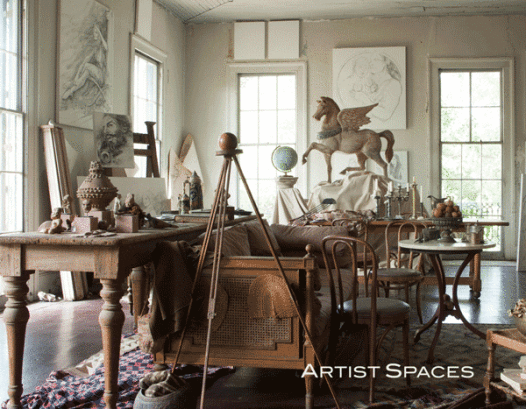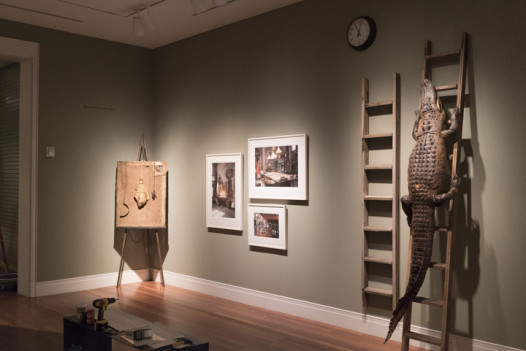
“George Dureau was interested in classicism, and he felt he was rewriting southern mythology with subject matter, drawings, paintings and photos,” Arthur Roger.
How do surroundings influence and contribute to the creative process? With that question in mind, ponder the powerful effect of environment on artistry shown in the current exhibition, Artist Spaces, on view at the Ogden Museum of Southern Art, through Sunday, Sept. 6.
In this soul-searching exhibition, curated by Bradley Sumrall, photographer Tina Freeman explores the intimate realms of artistic personality. Juxtaposing interiors with masterful examples of each artist’s work, she highlights the interrelationships between creativity and space. Formerly a commercial photographer whose work has been published in Elle Decor, Country Life, Veranda and New York Times Magazine, Freeman is acclaimed for her uncanny ability to photograph subjects using only soft, natural light. In the Ogden show, she captures the emotional character of 21 unique workspaces, revealing curious insights into artists’ personal and creative processes.
ARTIST SPACES WAS 40 YEARS IN THE MAKING.
Freeman began photographing artists in their milieux back in 1975 when she owned a New Orleans art gallery. She met Andy Warhol who later allowed her to create a portrait of him in Paris. In turn, he introduced her to painter David Hockney and Henry Geldzahler, curator of 20th century art at the Metropolitan Museum in New York. But it was not until 2005 that Freeman resumed this intensely personal project, photographing friend and master painter George Dureau in his French Quarter Dauphine Street studio.
Freeman had known several of the artists for decades, giving her additional insight into their artistic personalities. She and Ersy Schwartz have been friends since grade school, “playing in the mud.” Dawn Dedeaux and Freeman were coworkers in the 1970s at New Orleans Museum of Art.
Freeman refers to her studies as “portraits without people,” believing the spaces can often tell more about the artists than their own images. The Ogden installed the studio portraits beside samples of the artists’ works, demonstrating a certain symmetry.
“When Tina brought the idea to the Ogden, I immediately started thinking about the objects from the permanent collection and from the artists’ studios,” Sumrall says.
The curator was already familiar with most of the artists and had exhibited a few, but never met Elenora “Rukiya” Brown whose totemic sculpture is a real “stunner.” Brown’s dolls, quilts and costumes recall the city’s African heritage and magic.
“That was a real revelation to me,” Sumrall says.
DECORATORS DE-PERSONALIZE THE SPACE.
Freeman’s large format photography provides voyeuristic access to aesthetic spaces for curious inspection, as if the artists at work had been magically whisked away. Freeman’s desire is to make viewers feel as if they are in the same space, while conveying a sense of spontaneity. She does, however, choose the optimal the time of day for sunlight.
“I found myself one too many times hired to shoot houses that a decorator altered for his or her purposes, ruining the human feeling so that the designer could sell his brand or idea,” says Freeman, recalling her publishing career.
Elizabeth Shannon, for example, had been concerned about the clutter in her work space, but rearranged nothing before the shoot. To capture a space like Shannon’s, Freeman used a combination of shots: landscape-like interiors mixed with detailed shots of collections.
These local artists, who often combine living quarters with work spaces, demonstrate a reverence for history. Architectural elements and heirlooms accent airy and lightly unadorned studios. From brass chandeliers and pewter candlesticks to worn wallpaper and sanded plaster walls, fireplace mantels and rustic cupboards, Louisiana’s past is ever-present. There is little doubt these are Southern artists.
“Artists are their spaces,” says Nicole Charbonnet, a painter who uses texture, fabric, words, images and washes. Her Lower Garden District work space is a spacious, attic studio where she can easily move with the spirit from one canvas to the next.
“The space has to inspire us. Our spaces mirror our insides and our minds,” Charbonnet says.
Shannon’s live/work space is the warehouse of a former department store in the Upper Ninth Ward, crowded with sculptures, vignettes constructed out of timeworn salvage materials, found rescued objects and new works that mirror the Louisiana ecosystem.
Most eschew the popular trend toward minimalism, displaying numerous objects – wall hangings, ceramics, draperies, piles of books and photographs, always in view as if to pique their creativity.
MAXIMALISM
“I am the opposite pole of a minimalist, a maximalist, as it were,” Josephine Sacabo says. “It’s all part of my world. I can put anything in a place, and I like it there. I like a mix of things.” Her Bywater studio is a 19th century warehouse with a printing press to make engravings.
“Ambiance is important and, of course, I need things around me to inspire me. But the space overall is the main inspiration,” says Sacabo.
THE NATURAL ENVIRONMENT ALSO INSPIRES.
Van Gogh had Arles and Gaughin had Tahiti; George Dunbar’s studio overlooks the bayou.
“I see things floating, vegetable matter, especially after storms. They have texture and color. They fascinate me,” Dunbar says.
Before the exhibition opened in March, Freeman published a book with writer and longtime collaborator Morgan Molthrop. Also titled Artist Spaces, the book allows each artist to express in his or her own words the importance their workplaces have on their body of work.
Molthrop notes, “Tina’s photographs in the book translate the artists’ live/work spaces into a two-dimensional format that masterfully draws the eye in, but the Ogden show brings aspects of the art itself back into the three-dimensional realm.”
Artist Spaces continues through Sept. 6 after which it will travel to other regional museums.
 NOLAbeings
Multimedia artist Claire Bangser created NOLAbeings as a portrait-based story project that marries...
NOLAbeings
Multimedia artist Claire Bangser created NOLAbeings as a portrait-based story project that marries...
 Data corner: Adobe Suite (create a PDF, social media graphic, presentation, edit a photo and video
Data corner is where you go to work with analytics and top tech skills. It takes on everything from PERL and SQL to Canva and Sprout Social.
Data corner: Adobe Suite (create a PDF, social media graphic, presentation, edit a photo and video
Data corner is where you go to work with analytics and top tech skills. It takes on everything from PERL and SQL to Canva and Sprout Social.
